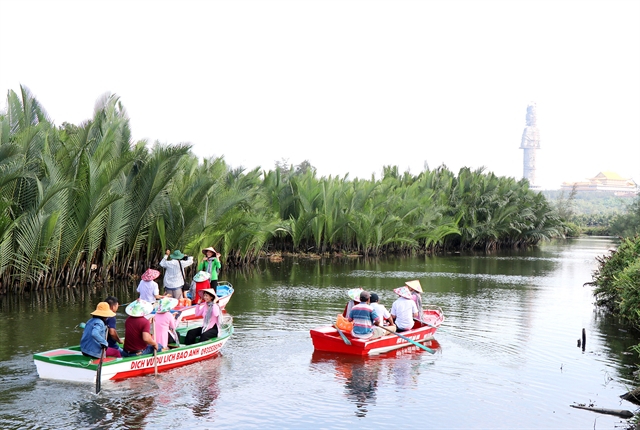 Life & Style
Life & Style

 |
| Bàu Cá Cái mangrove forest in Bình Sơn District, Quảng Ngãi Province. — VNA/VNS Photos |
HÀ NỘI — Economic pressures, particularly the wave of shrimp farming expansion, infrastructure development projects and natural disasters, have led to the devastation of most primary mangrove forests in the southern central region in recent years, seriously affecting the ecosystem.
In the spontaneous shrimp farming areas of Tịnh Kỳ, Tịnh Hòa, Tịnh Khê communes in Quảng Ngãi City, numerous ponds and farms, created by clearing mangrove forests, now lie abandoned. Residents have largely abandoned this type of farming due to water pollution, natural disasters and financial losses, Vietnaam News Agency reported.
Võ Mẫn from Mỹ Lai village, Tịnh Khê Commune, said he witnessed mangrove forests being wiped out.
Back in 1990, when shrimp prices were high, locals rushed to cut down the coconut forests to dig shrimp ponds.
These mangrove forests, which served as a green wall protecting coastal residents from storms and erosion and were home to many species of birds and fish, providing livelihoods for hundreds of households, but gradually disappeared, replaced just by shrimp ponds.
“At that time, for economic reasons, people traded the entire forest ecosystem for shrimp. Now, hundreds of shrimp ponds are abandoned, the land and environment are degraded, and the forests cannot be restored,” Mẫn said.
According to the Forest Protection sub-department under the Department of Agriculture and Rural Development of Quảng Ngãi Province, the area of natural mangrove forests in 2010 was more than 53ha but has now shrunk to only 17.6ha.
The main reasons for the disappearance of dozens of hectares of mangroves in province include spontaneous shrimp farming, storm damage, erosion and rising sea levels.
The shrimp farming movement has also rapidly reduced mangrove forests in Bình Định and Phú Yên provinces.
The Department of Agriculture and Rural Development of Bình Định Province reported that before 1975, the Thị Nại and Đề Gi lagoons had 1,000ha of mangroves, but now only 98ha remain.
In Phú Yên Province, research by the Institute of Natural Resources and Environment at Huế University indicates that the province previously had 13 main species of mangroves and 22 accompanying species, however currently, only two species remain in Ô Loan Lagoon.
Nguyễn Đình Quốc, a local resident said this area once had lush mangroves, but many households cleared them to dig shrimp ponds, causing the forests to decline. Now, only a few patches of mangroves remain near the shore.
With the loss of forests, fish and shrimp no longer have breeding grounds and overexploitation by local residents has depleted aquatic resources, with famous species like blood clam and shrimp becoming scarce.
Difficult to recover
 |
| Locals in Phú Yên Province take care of mangrove trees in Ô Loan lagoon. |
Khánh Hòa was once one of the provinces with the richest mangrove reserves in the southern central region.
Before 1975, the province had 2,500ha of mangroves. By 2010, only 104ha remained, according to the Institute of Oceanography in Nha Trang City.
The most significant loss occurred between 1990 and 2000, during the peak of shrimp farming. Locals cut down the mangroves, severely degrading the forest structure, resulting in a very low natural recovery rate.
In recent years, economic and social development projects have further reduced the mangrove area in Khánh Hòa.
According to the 2023 report on the forest status of Khánh Hòa Province, the locality's mangrove forest area has dwindled to just 48.23ha.
Associate Professor Dr. Võ Sĩ Tuấn, chairman of the provincial Marine Science and Technology Association, said that these mangrove forests, home to diverse and rare ecosystems, have largely been destroyed to accommodate aquaculture in the past and are now being replaced by tourism and residential developments.
In addition to economic activities and human demands, climate change and extreme weather events are significant contributors to the decline of mangrove forests.
Reviving mangrove forests
The degradation of mangrove forests in the southern central region has led to severe coastal erosion and a decline in nearshore fisheries.
Recently, local communities, national and international organisations have collaborated to restore and replant these crucial ecosystems, resulting in the reforestation of hundreds of hectares of previously barren, eroded land.
In Quảng Ngãi Province, the once desolate Bàu Cá Cái Lagoon is now lush with millions of mangrove trees, revitalising a diverse ecosystem. These mangroves not only protect against wind and storms, but also attract birds and support the return of fish, shrimp and crabs.
From 2014 to 2021, Quảng Ngãi Province invested approximately VNĐ33 billion (US$1.29 million) in three projects aimed at planting, nursing and regenerating mangrove forests. This effort has restored over 109ha of mangroves in Bình Sơn District.
To provide sustainable livelihoods, the province implemented a project in 2022 funded by the Global Environment Facility. This initiative, aimed at empowering communities to conserve ecosystems and cultural knowledge, involved training locals and forming management groups.
In Bình Định, efforts to restore and expand mangrove forests have been ongoing since 2003. Projects include reforesting Cồn Chim Ecological Area and expanding mangrove planting along Thị Nại and Đề Gi lagoons. To date, nearly 90ha of new mangrove forests have been established in the province.
Trương Xuân Đưa from the Bình Định Agricultural Research and Application Centre highlighted that these reforested mangroves are crucial for preventing erosion, restoring ecosystems, creating jobs and improving the local economy.
Phú Yên Province has also initiated a VNĐ18 billion ($708,240) mangrove planting project at Ô Loan Lagoon, which will cover 50ha.
Lê Văn Bé, Deputy Director of Phú Yên's Department of Agriculture and Rural Development, said that the new hectares of mangroves will provide habitat for aquatic species, enhancing biodiversity and supporting local fisheries.
Provinces are also promoting ecotourism in mangrove forest areas.
Quảng Ngãi is promoting ecotourism in its mangrove forests at Bàu Cá Cái, Cà Ninh, and Tịnh Khê. The community group protecting Bàu Cá Cái ecosystem includes 53 members engaged in sustainable tourism and fishery management, attracting over 10,000 visitors annually.
According to Đinh Tiến Dũng, Director of Quảng Ngãi's Department of Culture, Sports, and Tourism, the province aims to develop rural and agricultural community tourism as a key product.
Sustainable development solutions
 |
| Tourists visit the nipa palm forest in Tịnh Khê Commune, Quảng Ngãi City. |
Sustainable development efforts in southern central provinces are underway, focusing initially on mangrove forest restoration as part of a broader strategy.
To ensure long-term effectiveness, local authorities are prioritising community involvement in restoration, protection and benefit-sharing initiatives.
Quảng Ngãi Province, for instance, plans to expand its protective forest coverage to more than 2,820ha by 2030, with a focus on mangrove and freshwater forestation.
Technical measures and successful models from other provinces inform these efforts, aiming to enhance mangrove resilience against environmental stressors like coastal erosion, said Hồ Trọng Phương, director of the provincial Department of Agriculture and Rural Development.
Collaborative projects in Bình Định, Phú Yên provinces and Nha Trang City further underscore the importance of community engagement in forest protection and development.
Phú Yên Province is seeking non-state investor participation in reforestation efforts while supporting local communities with seedlings and scattered planting initiatives.
Experts emphasise the need for specific mangrove forest planning and community empowerment to ensure the sustainability of these initiatives.
Nguyễn Thị Thúy Huyền, national coordinator of the Global Environment Facility's Small Grants Programme, proposed that communities should be granted greater authority in managing, exploiting and protecting aquatic resources.
"By providing more benefits, people and communities will be motivated to develop plans for planting and safeguarding forests," he said.
In the short term, this approach ensures that people can benefit from the forest, reducing the government's burden of ensuring their livelihoods, while also mobilising community participation in forest protection.
In the long term, this strategy could eliminate the need for government funding in forest management and protection.
According to a member of the Global Environment Facility Project Tô Vạn Hạnh, forests with stable structures and tourism potential should be used to enhance the connection and interaction between local residents and the forest.
Local authorities should boost awareness campaigns on the value of mangrove forests, offer tourism skills training for locals and develop diverse tourism products. Involving businesses in supporting community tourism efforts is also essential. — VNS




